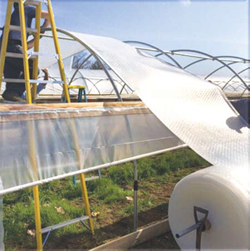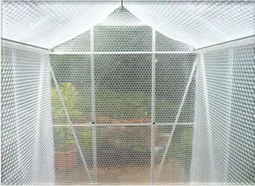
Something all greenhouse owners have in common is the great satisfaction that comes from a greenhouse in summer. In the warmer months, your greenhouse is a fantastic energy converter; sunlight streams in and warms up the interior quickly, providing the perfect little world for your plants. However, during the colder months, we greenhouse owners are ripped apart into two camps – heated and unheated.
In winter there is very little warmth to be had from the sun and in some parts of the country, there may actually be very little direct sunlight. So without heating, gardeners turn to all sorts of methods to try and hold onto whatever warmth the greenhouse has and of course to try to protect tender crops from frost. Bubble wrap is a common solution but for new gardeners, it can be a daunting task. Allow me to take some of that fear away with some more explanation and some practical advice to greenhouse bubble-wrapping novices. Why Bubble Wrap A Greenhouse? The purpose of adding bubble wrap is to provide a layer of insulation. But it is best not to go for the average packaging variety, and instead go for horticultural bubble wrap. Horticultural bubble wrap is not only extra thick but the bubbles themselves are larger and it is these bubbles, or air pockets, that provide insulation. Double glazing works exactly the same way, creating an air pocket between two panes of glass to slow down the transfer of heat and cold. The idea with bubble wrap is to retain any valuable heat in the greenhouse during the day and prevent the greenhouse from being affected by frost at night. This insulation can increase the temperature inside the greenhouse by one or two degrees, so it is not to be sniffed at!
How to Bubble Wrap A Greenhouse
This is best done after the annual clean. Make sure all the glazing is clean, nooks and crannies are clear and a general purge of dirt, pests and disease has been done. Give the greenhouse a chance to air and dry after cleaning. It is important to reduce the moisture inside as once the greenhouse is wrapped, you will lose access to your windows and vents.
Choosing your bubble wrap is important. Packing bubble wrap will offer little insulation and will deteriorate when exposed to the elements and sunlight.
Proper horticultural bubble wrap is thicker and treated so that it withstands UV damage, meaning it will last 2 or 3 seasons. It is important to consider the longevity whilst we all do our best to reduce our single-use plastics.

Now for the fun part. The best way to bubble wrap the greenhouse is to use long continuous sheets, cut and join as little as possible to reduce heat loss. I’ve found this works best by wrapping horizontally with long lengths from one side of the door, around the greenhouse to meet the opposite side of the door frame starting at ground level. You can secure the bubble wrap as you go with sticky tape or with little plastic greenhouse pegs designed to clip into the channels in your greenhouse frame.
What to Watch Out For
There are pros and cons to this method of insulation, and the most obvious con is that anything covering the glass will reduce the light coming into the greenhouse. The bubble wrap acts as a diffuser stopping direct sunlight and in favour of a much softer (weaker) light.
If you live in an area where sunlight is very reduced in the colder months, this is something to consider to ensure your plants get the appropriate amount of light and you may decide to employ any means of lighting.
Another consideration is that once wrapped, you will lose the ability to access the vents and windows. This means air cannot circulate as well and excess moisture cannot leave the greenhouse. This could cause problems with build-ups of condensation which in turn can harbour moulds and encourage disease, so you do have to be vigilant. You can open the greenhouse door to vent the moisture but it is at the detriment to that hard-won heat.
If you are unsure of the benefits, there are alternatives to wrapping the whole greenhouse. You could try dividing the greenhouse and insulating only one part, or even use bubble wrap to insulate just one staging bench, creating a microenvironment within your greenhouse. Or clever use of propagators or cold frames within the greenhouse can help offer some protection on a smaller scale. For other ways to increase temperature in the greenhouse in an eco-friendly way, Greenhouse interior with bubble wrapping complete.
Keeping Your Crops Warm
Why not line the inside of your polytunnel or greenhouse during the winter months with Bubble wrap to help cut down on drafts, but still let some light through. Bubble wrap is essentially a plastic sheet, which has air bubbles and when fitted inside your polytunnel helps to reduce heat loss and also helps to improve insulation. Bubble wrap inside your polytunnel can provide an ideal way of giving a cost-effective solution to your insulation needs. As quoted by Bob Flowerdew “The ‘double glazing’ and also lagging the inner tunnel with bubble plastic in winter gives remarkable insulation”
For more details:
HEGAZY PACK LTD
NAIROBI Tel. 0700 297 277
www.hegazypack.com
ahmed@hegazypackltd.com
